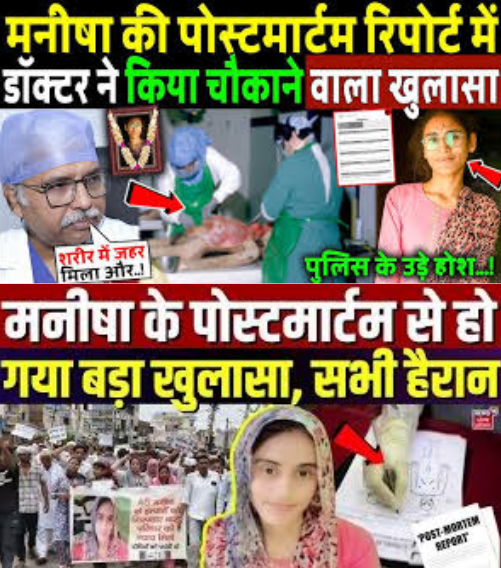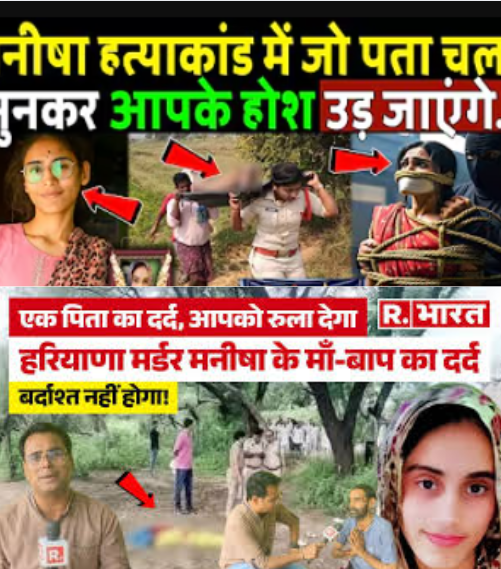Doctor made a shocking revelation in Manisha’s postmortem report! Bhiwani Manisha Murder Case
On the morning of August 13, 2025, a phone call reached Loharu Police Station in Haryana that would set in motion one of the most disturbing and mysterious cases the district of Bhiwani had ever seen. The body of a young girl had been discovered in a brutal state near the Singhani canal. Within hours, the name “Manisha” was being whispered in shock and sorrow across the region. Who was she, what had happened, and why had the system failed her so tragically?
Manisha was a bright, ambitious girl from a middle-class family in Bhiwani. Her father, Sanjay, worked hard to support the household, and though the family wasn’t financially strong, Manisha had big dreams. While working as a teacher at Singhani Play School to help the family, her ultimate goal was to become a nurse. She was preparing for the B.Sc. Nursing entrance and had recently learned that application forms had been released.
On August 11, Manisha followed her daily routine. She attended school in the morning and later called her father to ask permission to go to college and fill out her nursing form. Sanjay agreed, unaware that it would be their last conversation. Around 4:00 PM that afternoon, he received a call from Manisha’s number—but there was no voice on the other end. The call dropped. Sanjay tried calling back, but her phone was switched off. Instantly, he felt something was wrong.
Worried, he rushed to the college where Manisha was supposed to go. He spoke to the security guard and staff members, including three men at the reception who appeared intoxicated. They denied seeing her. Suspicious, Sanjay called the police and requested an investigation. However, the officers seemed indifferent and casually suggested, “Maybe your daughter has eloped.” Sanjay was adamant—his daughter would never do such a thing. He filed an official FIR, but the case was not taken seriously. The FIR was not formally registered until the evening of August 12, nearly 30 hours after she went missing.

The very next morning, on August 13, the police received a call about a body found near the Singhani canal. When they arrived at the scene, they were shaken by what they saw. A young girl’s body lay in horrific condition. Her clothes were torn, her face was disfigured beyond recognition, and nearby were her shoes and dupatta. It was difficult to identify her, but when Sanjay and his family were called in, they recognized her clothing. It was Manisha.
The sight of her daughter’s body crushed Sanjay. The entire family broke down, while the village collectively mourned. What followed was a wave of public outrage—not just over her death, but the way it had been handled. Villagers accused the police of negligence, arguing that if they had acted quickly on August 11, Manisha’s life might have been saved.
Initially, the police suspected sexual assault followed by murder. But when the postmortem was conducted, a different truth emerged. There was no evidence of acid being thrown on her, contrary to earlier rumors. There were also no physical signs of sexual assault. However, traces of pesticide—a toxic insecticide—were found in her system. That discovery opened a new line of investigation: was it suicide?
Further deepening the mystery, police reviewed CCTV footage from around the area. One clip showed Manisha leaving school and stopping by a shop to buy pesticide. It appeared she had purchased it willingly. No footage confirmed that she reached the college after that. Then came another twist—on August 18, police recovered a handwritten note believed to be a suicide note. In it, Manisha wrote:
“Sorry Mummy Papa. I am going far away from you. I can’t bear to see you both in trouble.”
The note, when analyzed, matched Manisha’s handwriting. The words were simple but heartbreaking. It seemed to indicate that Manisha took her own life to avoid burdening her family. But if that were true, why was her body found in such a brutal state? Why were her clothes ripped? Why was her windpipe crushed and pulled out? Who damaged her face?

These questions shattered the suicide theory. It became increasingly clear that even if Manisha had consumed poison, there was more to the story. She could not have inflicted such violent injuries on herself. So, did someone find her after she was poisoned and try to make it look like murder—or worse, did someone force her to consume the pesticide and then killed her?
The police, facing heavy criticism, reopened the investigation from multiple angles. They repeated the postmortem and began questioning all people in contact with Manisha that day. Meanwhile, the community organized protests and demanded justice, blaming both the police and possibly even the college staff who had failed to cooperate in the early hours of her disappearance. When Sanjay had requested the CCTV footage from the college on August 11, he was told the surveillance room was “closed for the day” and would be checked “tomorrow.” That delay could have cost Manisha her life.
Several theories began to emerge. Some believed Manisha might have been emotionally manipulated by someone—perhaps a relationship gone wrong, or someone from her environment who mentally harassed her. Others believed she was lured or blackmailed, and when she resisted, things turned violent. The three men Sanjay met at the college reception were also looked into. Why were they intoxicated on duty? Why did they lie about students not being present? Were they protecting someone?
There were also whispers of family pressure, though Manisha’s parents insisted they were supportive of her dreams. Still, the existence of the suicide note raised painful doubts: was she battling silent mental health struggles? Was she overwhelmed by expectations and poverty? Or was that note part of a setup—a tool to mislead investigators?

The case is still unsolved. The police say they are committed to finding the truth, but the damage is done. A brilliant young woman with dreams of healing others was found lifeless, her body disrespected even in death. Her voice is gone, but her silence speaks volumes about the systemic failures, the gender-based pressures, and the apathy of institutions meant to protect her.
Manisha’s story is not just a mystery—it is a tragedy. A tragedy of delayed action, ignored warnings, and a bright future stolen in broad daylight. In a country where girls fight every day for education, safety, and respect, Manisha’s case should serve as a wake-up call.
Her community continues to ask: Was it truly suicide? Or was Manisha silenced by someone who knew she wouldn’t survive to tell the truth?
Until that question is answered, justice remains incomplete.
Play video :
News
Sachin Tendulkar’s Son Arjun Tendulkar Gets Engaged To Saaniya Chandhok | Who Is Saaniya Chandhok?
Sachin Tendulkar’s Son Arjun Tendulkar Gets Engaged To Saaniya Chandhok | Who Is Saaniya Chandhok? In a surprising yet joyous…
Navya Naveli Insults Rekha After Amitabh Bachchan And Rekha Marriage Decision
Navya Naveli Insults Rekha After Amitabh Bachchan And Rekha Marriage Decision In the world of Bollywood, few stories are as…
Puneet Superstar Was Beaten Up Publicly On The Road In Delhi
Puneet Superstar Was Beaten Up Publicly On The Road In Delhi In a disturbing turn of events that has left…
KHUSHI KAPOOR & REBEL KIDS BULKY VENEERS: KUSHA KAPILA’S SMILE TRANSFORMATION
KHUSHI KAPOOR & REBEL KIDS BULKY VENEERS: KUSHA KAPILA’S SMILE TRANSFORMATION In recent years, cosmetic dentistry has surged in popularity,…
JENNIFER WINGET’S EX HUSBAND WAS MANIPULATIVE: BIPASHA & KARAN SINGH GROVER BEING SELF OBSESSED
JENNIFER WINGET’S EX HUSBAND WAS MANIPULATIVE: BIPASHA & KARAN SINGH GROVER BEING SELF OBSESSED In the Indian entertainment industry, few…
Aishwarya Rai Bachchan Donate Her Blue Eyes, Salman Khan Donate His Bone Marrow
Aishwarya Rai Bachchan Donate Her Blue Eyes, Salman Khan Donate His Bone Marrow In a world increasingly shaped by celebrity…
End of content
No more pages to load









